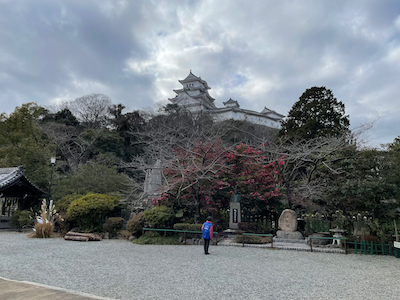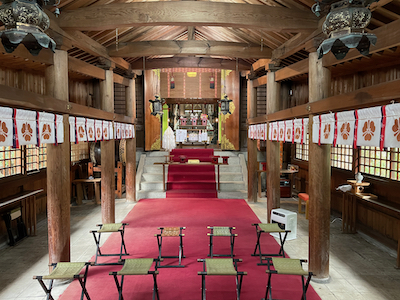Last week, I went with one of my colleagues from Jinja Honchō to visit Himeji Jinja, and talk in more detail about what they are going to do, and what support they need. This was a day trip, which was a bit of a push because Himeji is about 500 km from where I live. It was also, however, extremely valuable. It really is very helpful to visit a place in person when you are going to write guidance for visitors.

For example, this is the view of Himeji Castle (a World Heritage Site) from within the jinja precincts. The jinja is within the area of the World Heritage Site, which puts limits on the building they can do, but also means that there is a really nice backdrop if you want to have photographs taken there. That’s not so relevant to the provision for foreign visitors, because you can get pictures with Himeji Castle in the background anywhere in the vicinity, but it would be a strong point when encouraging more local people to go there for weddings or shichigosan. We did talk about that while we were there (mostly my colleague on that topic).
We also looked at where the special prayers would be offered, and this is the prayer hall where it would happen. (The main sanctuary is up a flight of steps, behind glass doors, up the flight of steps with the offering table on, and the doors to it are closed. That’s one reason why I was allowed to take this photograph, with the understanding that it would be used online. The other reason is that publicising this project is rather the whole point.)

As you can see, there is plenty of space for a family or group of friends to sit together while the norito is offered, and the whole room has a nice atmosphere. One of the hidden advantages of this prayer hall is that you do not need to take your shoes off to go inside. That would make it much easier for tourists to divert from Himeji Castle and visit the jinja for a matsuri. There is even an “outer prayer hall” outside this one, where people could wait while the priests were preparing for the matsuri, or while the previous group had their matsuri, if things became busy.
The chief priest of the jinja likes writing norito, and so the plan is to prepare specialised norito for a range of requests that might be appropriate for foreign tourists. Prayers for a safe trip are the obvious one, but prayers for improvement in Japanese language skills, or for opportunities and success in learning about Japanese culture, or even for successful applications for permission to live in Japan are also a possibility.
So, the next step of the project is for me to prepare proposed English texts to both explain to people what can be done and what is happening, and allow them to apply for a matsuri even if they do not speak any Japanese, without running the risk of a translation app getting something critical wrong. (More languages are possible in the future, but I can’t do it. In the meantime, a lot more people speak some English than speak some Japanese, so the English should help.)
We are also working on the jinja’s website, which is making progress. I can’t link to it yet (it hasn’t made quite that much progress), but the next update, or the one after that, about this project will almost certainly include a link.
The trip was extremely useful, and definitely worth Jinja Honchō paying for us to go, but I think one of the main reasons it was so useful was because we had had several web meetings beforehand. Hybrid structures are, I think, going to be very important in a lot of fields in the future, but there still needs to be some work on finding the ideal patterns.
Our plan was to have everything ready by March, and that still looks possible.
That all sounds very promising – I look forward to visiting and relying on your work!
Aloha David! In all my project development work we always begin with the desired benefits to all parties involved. Then we work backward to figure out how to deliver the desired benefits in a way which works for all parties involved. In my study of Shinto this emphasis on possible BENEFITS to all parties involved has seemed a little vague. Enjoying learning about this Himeji Jinja project. Thank you for sharing.